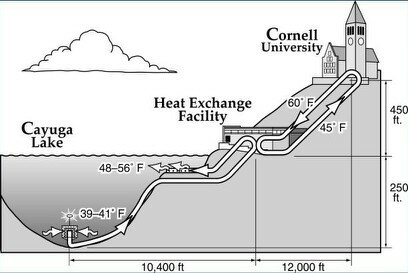Tue 22 Jun 2004

WorldChanging reports:
While this isn’t new, I just learned about it today, and thought I’d pass it along. Cornell University, since 2000, has used a system called “Lake Source Cooling” to cool buildings during the warm Ithaca summers. The technique is fairly simple, and works extremely well. By no longer using traditional air conditioning, the university was able to reduce its cooling-related power consumption by 80-90%, and the campus’ overall demand by 10%; in 2001, that meant a reduction in CO2 emissions of over 21 million tons.
Because the old air conditioning systems were falling apart (as well as environmentally hazardous due to the choloflorocarbons in the cooling system), in the mid-1990s Cornell needed to find a replacement. At around $60 million, the LSC project cost more than a direct upgrade to modern conventional cooling systems; since it is designed to have a 75-100 year lifespan, as opposed to the 30-40 years of a traditional cooling system, and results in such a dramatic reduction in energy consumption, the real cost difference was minimized.
The lake water heat-exchange system is fascinating. While it is obviously not universally appropriate, it’s an excellent example of working with the environment instead of against it. For those of you concerned about the effects of returning warmed water to the lake, the environmental impact statement makes for good reading (in short, the warm water has a negligible effect on lake organisms, and has a heat effect the equivalent of 2-4 hours of additional sunlight per year). The primary negative effect of the LSC’s operations appears to be a 3% increase in phosphorus during the summer months, which contributes to the growth of algae near the outflow pipes.